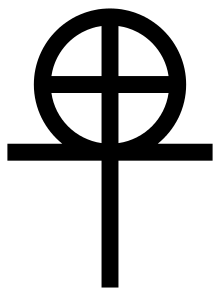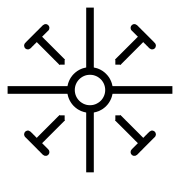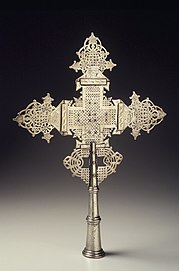Coptic cross
The term Coptic cross may refer to a number of Christian cross variants associated in some way with Coptic Christians.

"Coptic crosses" are often shown with arms dividing into three points each (also called "Ethiopian cross" or "Axum cross"; Liungman (2004) shows a symmetrical cross fleury.[2] Bertran de la Farge (in La Croix occitane) identifies a cross crosslet as "croix copte (4ème siècle)" and cites it as a predecessor of the Occitan cross somewhere in the marquisate of Provence, probably Venasque.[3] Old Coptic crosses often incorporate a circle,[4] as in the form called a "Coptic cross" by Rudolf Koch in his The Book of Signs (1933). Sometimes the arms of the cross extend through the circle (dividing it into four quadrants), as in the "Celtic cross".
Modern form
The form used in the Coptic Church and defined as the Coptic cross is made up of two bold lines of equal length that intersect at the middle at right angles. At each angle are three points, representing the Trinity of the Father, the Son and the Holy Spirit. All together, the cross has 12 points symbolizing the Apostles whose mission it was to spread the Gospel message throughout the world.[5]
The Coptic cross is widely used in the Coptic church and the Ethiopian and Eritrean churches. Many Copts have the cross tattooed as a sign of faith on the inside of their right arm at the wrist.[6] The Coptic cross in its modern and ancient forms is considered a sign of faith and pride to the Copts[7] The Ethiopians Christians wear it as a symbol of faith.[8]
In 1984, a Coptic Cross was given as a gift by the Coptic Orthodox Church and mounted on the top of the All Africa Conference of Churches building, since the Coptic Church is considered to be the mother church in Africa.[9]
One of the forms of the Coptic cross, which is referred to as the Ethiopian Coptic cross[10] was worn by Stevie Ray Vaughan.[11] Keith Richards[12] also wears an Ethiopian Coptic Cross.
Gallery
 Cross with a circle
Cross with a circle A "Coptic cross" according to Rudolf Koch, The Book of Signs (1933)
A "Coptic cross" according to Rudolf Koch, The Book of Signs (1933)- Illuminated early form of Coptic Cross at the end of the 4th-5th century Coptic Codex Glazier.
 Wall painting of a jewelled cross from Kellia, Egypt, late 6th century.
Wall painting of a jewelled cross from Kellia, Egypt, late 6th century.- Coptic cross from the Ancient Egyptian Temple of Philae.
 Processional cross from Amhara Region, Ethiopia (mid 20th century)
Processional cross from Amhara Region, Ethiopia (mid 20th century)
See also
- Ankh
- Coptic Orthodox Church of Alexandria
- Coptic Catholic Church
- Alexandrian rite
- Christian cross
References
- "Patriarcato Copto Cattolico - Home". 13 April 2014. Archived from the original on 13 April 2014.CS1 maint: BOT: original-url status unknown (link)
- Liungman, Carl G. (2004). Symbols: Encyclopedia of Western Signs and Ideograms. Ionfox AB. p. 228. Retrieved November 10, 2018.
- "La croix occitane, dossier réalisé par O.Lamarque et C.Pujol, d'après un texte de Bertran de la Farge" (PDF). disciplines.ac-toulouse.fr (in French). Archived from the original (PDF) on 2016-10-11. Retrieved 2016-08-06.
- "The Coptic Cross". Seiyaku.com. Retrieved 2011-01-02.
- Goldman, Ari L. (1989-10-10). "Coptic Pope's Visit Cheers Faithful - The". New York Times. Retrieved 2011-01-02.
- "Deep Thoughts: Coptic Orthodox Tattoo". Mojoey.blogspot.com. 2005-01-19. Retrieved 2011-01-02.
- http://www.coptic.net/pictures/Icon.Cross.gif
- "Ethnic craft". Archived from the original on 2004-10-22.
- "Coptic Africa" (PDF). Archived from the original (PDF) on 2011-07-22. Retrieved 2011-01-02.
- "Alternative Religions". Altreligion.about.com. Retrieved 2011-01-02.
- "Stevie Cross". Stevieray.com. Retrieved 2011-01-02.
- "Keith Cross". ?. Retrieved 2012-01-21.
